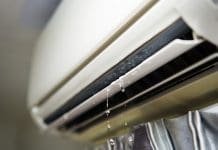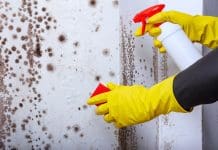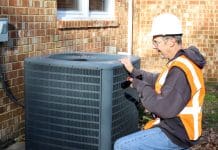National trade body the Property Care Association has seen a significant rise in the number of homes across the UK with atmospheric moisture issues. Chief executive Steve Hodgson gives an insight into how modern life is one of the major contributing factors behind a new generation of humid, damp homes
We’ve seen a surge in the levels of excess moisture in properties across the UK, with many of our 400 members encountering higher levels of humidity and wetness in homes at any one time.
A range of factors associated with modern living and the way dwellings are occupied can be linked to this rise.
And this is not a situation without consequence. Left unchecked, the resulting problems from excess moisture can include poor air quality, condensation, dampness and mould – blighting homes and affecting quality of life for occupants.
The legacy of modern living
Many of us can relate to changing habits in modern properties. The more sedentary nature of life today, greater levels of home working, concerns about child safety and our ageing population may all be factors that now see the average person spending a far greater time inside than in the past. Some research indicates that up to 90% of our time is spent indoors.
What we do in these buildings is also different. Anyone aged 40 and over will relate to the fact that baths used to be a once a week experience. Now, many of us will live in homes where each occupant showers and/or bathes twice a day.
Laundry is probably done more frequently too and central heating means radiators provide a perfect place to dry off the washing, while the chimneys for traditional coal fires end up largely sealed off to prevent draughts.
On top of this we can add the consequences of trying to be more energy efficient. The drive to reduce heat loss is in part achieved by stopping heat escape through openings and gaps in the building fabric. Retrofit insulation, draught exclusion and high-performance windows all achieve this brilliantly. However, unfortunately, those same gaps that gave rise to heat loss also took away excess airborne moisture. The end result is properties modelled on the concept of a sealed unit.
The unintended consequences of poorly installed retrofit insulation should also be considered, as well as the fact that new houses are getting smaller – and in some pockets of the country occupancy levels are increasing too.
The impact
Smaller spaces with higher levels of occupation, coupled with the other factors discussed above, all contrive to put strain on the capacity of a dwelling to absorb and manage atmospheric moisture effectively. The outcome of this is that the additional air moisture loading resulting from this change of lifestyle can be very significant.
We take all this and then add to the mix the implications of high energy costs. With the cost of heating buildings increasing, people understandably take the decision to use less energy – which in turn reduces the capacity of the air to hold the water created by occupation.
The consequences of sporadic, uneven or inadequate heating can lead to issues associated with elevated Relative Humidity (RH). RH is the amount of water held in the air expressed as a percentage of its capacity to do so.
This figure is dependant not only on the amount of water in the air as a vapour, but also by the temperature of the air at any given time. In simple terms, the warmer the air is then the more water it can hold on to. In turn, if the air is colder it will hold on to less water.
Mould growth typically occurs in a building at around 65% RH to 95% RH and from five degrees to 40 degrees Celsius – with the optimum conditions somewhere in the middle of these ranges.
Together, these factors are providing the perfect environment for mould growth to thrive.
And as we can be pretty certain our social habits are unlikely to change suddenly, there’s a pressing need to look at ways to balance indoor air quality to create the best environment for our homes.
The Ventilation Effect
It is our belief that a greater focus on more effective ventilation in UK homes is the single most important element needed to help tackle the problem of atmospheric moisture in buildings.
However, despite the impact it can have on a property’s moisture levels, the current regulation and guidance setting out minimum requirements in homes is mixed and usually ignored or misunderstood. To address this, PCA recently established the Residential Ventilation Group (RVG) to signpost people to specialists capable of designing and delivering residential ventilation solutions that are right first time.
It’s a step in the right direction – but with so many factors to consider, much more needs to be done to address the issue effectively across the industry. Ultimately, we need to see a more robust strategy to ensure effective ventilation methods are introduced in homes.
Widening the debate
Cross-industry support, working in partnership with academia, is going to be crucial to find future solutions. We hope to draw in further engagement through our two-day International Residential Ventilation & Preservation of Buildings Conference.
Taking place on 14-15 June at The Slate, University of Warwick, in Coventry, the conference – open to all with an interest in the subject – will investigate issues including the nature of occupation, methods for identifying and rectifying defects and the expected performance of existing buildings.
To broaden the debate and bring together the latest thinking on the issue, original research/academic papers on topics related to moisture in buildings are being presented at the event.
PCA is also undertaking a Knowledge Transfer Partnership (KTP) with the University College London Institute for Environmental Design & Engineering (UCL IEDE), which should further advance methods of managing excess water in homes.
It’s a two-year project, with researchers from the UCL IEDE tapping into the expertise of the association to undertake extensive data analysis in properties across the UK.
The research will consider the factors that can have an impact on a building’s performance, such as the lifestyle of its occupants, the structure’s condition and climate.
With this information on board, together we hope to develop a process that will help surveyors with the diagnosis and repair of damp buildings.
We are just about to start monitoring 40 homes across the UK to build a clear picture for this programme – a figure we believe makes it the largest research project of its type undertaken.
Our own finances and expertise are being used in the project to develop something that is not for commercial sale but developed in partnership with UCL for the common good.
As we move forward with the programme, we hope the situation continues to spark interest – and helps to lead innovative new ways to improve indoor air quality overall.
Steve Hodgson
Chief Executive
Property Care Association
Twitter: @PCAPropertyCare













